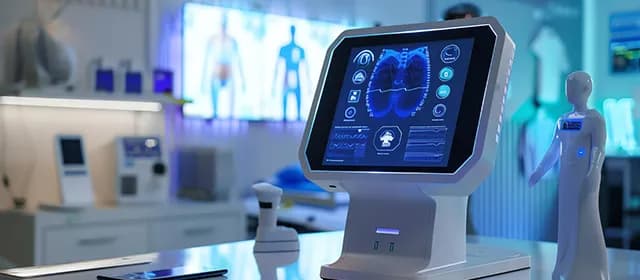Imagine living in a remote area without access to specialized medical care or residing in a bustling city where long wait times and limited doctor availability are the norm. In both scenarios, obtaining timely medical attention can be a daunting task, leaving individuals without the care they desperately need. This pain point has motivated the rise of a revolutionary solution: telemedicine.
With the rapid advancements in technology, this has emerged as a game-changer in healthcare, bridging the gap between patients and healthcare providers. According to Kings Research, the global telemedicine market is projected to reach a valuation of USD 275.67 billion by 2030. This article delves into detail about the billion-dollar industry.
What is Telemedicine?
Telemedicine is the practice of delivering clinical services remotely, allowing patients and healthcare providers to communicate in real time. This innovative approach addresses challenges in traditional healthcare delivery and offers numerous benefits for both patients and professionals.
A key advantage of this is enhanced access to healthcare, particularly for individuals in remote or geographically isolated areas. It enables convenient access to medical consultations and treatment, saving time and reducing transportation challenges, especially for individuals with limited mobility or in underserved regions. Some of the examples of telemedicine in India include Practo, Lybrate, etc.
Why is Telemedicine Important?
- Increased Access to Healthcare: It expands access to healthcare services, particularly for individuals living in remote or underserved areas.
- Convenience and Efficiency: It offers convenience for patients by allowing them to consult with healthcare providers from the comfort of their own homes. It eliminates the need for travel and reduces wait times, making healthcare services more efficient and accessible.
- Cost Savings: It can lead to cost savings for both patients and healthcare providers. By avoiding unnecessary travel and reducing administrative overhead, telemedicine can lower healthcare costs and improve cost-effectiveness in delivering medical services.
- Continuity of Care: It facilitates continuity of care by enabling patients to maintain regular contact with their healthcare providers, even when face-to-face visits are not possible. This can improve patient outcomes and support the ongoing management of chronic conditions.
- Emergency Response: In emergencies, it can provide rapid access to medical expertise and support, enabling healthcare providers to assess and treat patients remotely, potentially saving lives in critical situations.
Types of Telemedicine
- Real-Time Video Communication: This type involves live video interactions between patients and healthcare providers. It allows for immediate consultation and diagnosis, resembling traditional in-person visits but conducted remotely.
- Remote Monitoring: Remote monitoring involves the collection and evaluation of health data from patients in real-time, often using wearable devices or remote sensors. This data can include vital signs such as blood pressure, cardiac statistics, oxygen levels, and respiratory rates, allowing healthcare providers to monitor patients' health status from a distance.
- Store-and-Forward: Store-and-forward type involves the transmission and sharing of medical information, such as diagnostic images (e.g., CAT scans, MRIs, X-rays) and other patient data (e.g., photos, videos, text-based reports), between healthcare providers. This asynchronous method allows specialists to review patient information at their convenience, leading to more efficient consultations and treatment planning.
What Are the Uses of Telemedicine Beyond the Pandemic?
- General Healthcare: It enables patients to schedule wellness visits and receive routine care, such as blood pressure monitoring, without needing to visit a healthcare facility in person.
- Nonemergency Follow-Ups: Patients can conduct follow-up appointments with their healthcare providers remotely, allowing for ongoing monitoring and management of chronic conditions.
- Mental Health Counseling: It facilitates direct interaction between patients and mental health professionals through telephone or video conferencing, making mental health counseling more accessible and convenient.
- Nutrition Counseling: Healthcare providers can offer nutrition counseling sessions remotely, providing guidance and support for dietary management and healthy eating habits.
- Prescription for Medications: It enables healthcare providers to prescribe medications remotely, ensuring patients have access to necessary treatments without the need for an in-person visit.
- Physical Therapy Exercise: Patients can participate in physical therapy exercises and rehabilitation programs remotely, guided by healthcare professionals through telemedicine platforms.
- Tele-Intensive Care: It extends intensive care services to remote locations, allowing critical care specialists to monitor and manage patients in intensive care units from a distance.
Additionally, it is utilized differently across various fields of medicine, such as:/
- Telestroke: Emergency departments utilize this technology to connect neurologists with emergency doctors, enabling remote assessment and treatment of stroke patients and addressing shortages of in-house neurologists.
- Teleradiology: Healthcare practitioners send imaging studies and reports to remote radiologists for interpretation, enhancing diagnostic capabilities and facilitating timely treatment decisions.
- Telepsychiatry: Psychiatrists conduct therapy sessions and assessments remotely through telephone or video conferencing, improving access to mental healthcare services.
Addressing Drawbacks and Overcoming Challenges in Telemedicine
Here are some common drawbacks and strategies to overcome them:
1. Technological Challenges:
It encounters technological glitches, such as device malfunctions and poor internet connectivity, which can disrupt appointments. Individuals can mitigate these issues by ensuring their devices are functioning correctly and maintaining a stable internet connection. Additionally, clinics and hospital staff can provide technical support to patients experiencing difficulties.
2. Limitations in Physical Examination:
One drawback is the inability to physically examine patients, which can impact diagnosis and treatment. To compensate for this limitation, healthcare providers should ask detailed questions to gather comprehensive medical histories and consider additional diagnostic tests when necessary.
3. Patient-Doctor Rapport:
Building rapport and trust in a remote setting can be challenging. Both patients and healthcare providers should make efforts to establish a strong therapeutic relationship through effective communication and empathy.
4. Infrastructure and Security Concerns:
Access to high-speed internet and secure electronic health record (EHR) systems are essential for successful encounters. Clinics and hospitals must invest in robust infrastructure and cybersecurity measures to ensure patient data privacy and security.
5. Reimbursement Policies:
Medicaid, private payers, and Medicare may have inconsistent reimbursement policies, creating financial challenges for healthcare providers and patients. Individuals should stay informed about their insurer's reimbursement policies and use platforms to track expenses and document receipts.
6. Regulatory Compliance:
Telemedicine regulations vary across states, requiring practitioners to be aware of state-specific regulations and licensure requirements. Clinics and hospitals must adhere to these regulations to ensure legal compliance and patient safety.
End Note
Telemedicine represents a groundbreaking solution that revolutionizes healthcare delivery. By leveraging technology to bridge the gap between patients and healthcare providers, it offers improved access, convenience, cost-effectiveness, and enhanced patient outcomes. With advancing technology and widespread connectivity, telemedicine is positioned to have a crucial impact on the future of healthcare. It promises to enhance accessibility and efficiency, making quality medical care more readily available to everyone.




